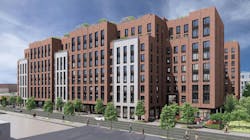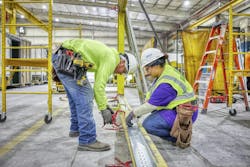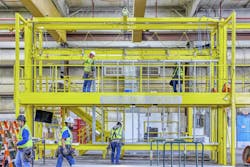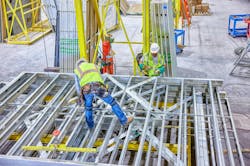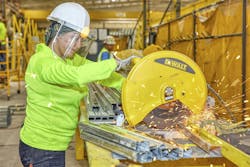How modular solutions can help address skyrocketing construction costs
Since the onset of the Covid-19 pandemic, we have seen record-high construction costs and delays that have affected almost every industry across the country. And, with the most recent report from CBRE, it's clear construction costs will continue to rise.
The global real estate services firm has predicted a staggering 14.1% annual increase in U.S. construction costs by the end of 2022—up from an 11.5% escalation in 2021, and far outpacing the historical average increase of two to four percent each year.
Although there might be some relief coming in the short term, there is no question the industry must adapt to a changing landscape. To combat these ever-rising costs due to supply chain disruptions, skilled labor shortages and inflation, there will be a fundamental shift in how projects are assembled and delivered.
THE FUTURE IS MODULAR
Modular building solutions are not new concepts by any means. They can be traced back all the way to antiquity when ancient Romans used a prefabricated system of assembling massive sections of roads that stretched hundreds of thousands of miles and can still be seen to this day. Debates about modular construction over on-site traditional construction have been ongoing for centuries, but modular performance has evolved—with better technology, more efficient processes and faster implementation—and is more credible now than it ever was.
Change can be difficult. However, when done right, modular design and construction can address some of the key challenges the industry is facing today. Read more about three key areas below.
1. Reducing skilled labor needs
According to the Modular Building Institute report in 2019, studies have shown a 2/1 margin of skilled labor leaving the market versus those that are coming into the market among the younger generations. In addition, the average age of skilled labor today is around 42.5, with around a 3/1 ratio of those workers over the age of 55 to those aged between 16-24. We will see well over 50% of the skilled labor sector retire over the next ten years with no one to replace them. This will result in substantial cost increases or lower-quality construction if something does not change.
Some of the most skill-intensive and expensive types of work (including mechanical, electrical and plumbing) can be transferred to manufacturing workers via an off-site warehouse that specializes in modular systems and solutions. The reason why this is successful is due to the assembly line process. One worker can be trained in a multitude of fundamental tasks, performed at a high level, never requiring certifications typical of on-site skilled labor.
In addition, a highly skilled and certified supervisor can oversee more tasks in a smaller area of a few thousand square feet, as opposed to running around a large job site of several hundred thousand square feet, attempting to supervise several crews. This provides an environment that results in fewer certified skilled supervisors, while providing a higher quality of supervision and fabrication, faster and at a lower cost.
2. Schedule compression
Schedule compression is one of the greatest benefits and likely one of the top reasons for deciding to utilize a modular solution in any construction project. A report by McKinsey in 2019 states that if the design is properly completed for full volumetric units (units that become the structure of the building and does not require additional support) and is closely coordinated with the manufacturer, there can be as much as 50% schedule compression.
While most of this compression is in fabrication and construction, the design stage also reaps benefits. Often overlooked, the design schedule can be significantly reduced by utilizing modular technology programs for the larger and more repetitious portions of the building, allowing designers to focus more on the primary or more critical features of the building design.
The fabrication will often begin even before groundbreaking, allowing fully-finished structural units to be delivered on-site as soon as the foundation or superstructure is suitable for installation. Fully-finished, load-bearing units can allow for as much as 80–85% of the facility to be completed off-site, thus providing the ability for a large, multi-storied building to be completed in weeks, not months or years, with only minimal on-site work required. All this equates to significant cost savings and early revenue generation.
3. Materials cost savings
There is no magic wand that makes materials cheaper simply because they are purchased and assembled off-site. Unless the manufacturer is using a proprietary system, the modular units are built with the same or similar materials as would be used in on-site construction, as specified by a traditional A/E design team.
Where many of the materials savings can be recouped is through waste reduction. Waste can be reduced to as low as two to three percent through a streamlined process, compared to average on-site construction waste of around 15 percent. Savings can be realized as early as the design phase. By designing for manufacturing and assembly, then implementing the design through a true manufacturing process, almost every inch of every piece of material is accounted for. In traditional on-site construction, 15–20% of waste is built into the cost estimate because field installation does not provide as precise of a calculation, resulting in many cuts and adjustments in the field from raw material leading to an excess in discarded, cut pieces.
In modular manufacturing, the cuts, and even the cut pieces, are calculated and used on other areas of the product to significantly reduce, and many times, eliminate waste. This is also assisted by utilizing generative design software to maximize efficiency and use of materials. With specific lengths and quantities, a licensed manufacturer is also able to order directly from the materials manufacturer—not a materials supply house as sub-trades would be required—providing additional cost savings and further reducing waste and fabrication time in the shop.
THE PROFITABILITY OF MODULAR
To remain profitable and relevant in today’s ever-changing, fast-paced world, the construction industry needs to seriously consider the benefits of modular. Of course, there are countless nuances not discussed here, but the hope is to introduce modular thinking in a way that highlights the most important items for potential cost savings.
About the author: Josh Mensinger is the executive vice president of ModularDesign+, a full-service modular design and prefabrication company located in Dallas-Fort Worth, Texas.
